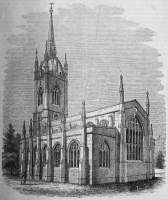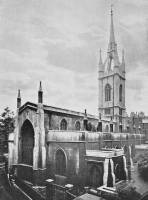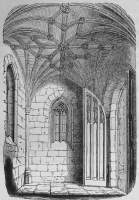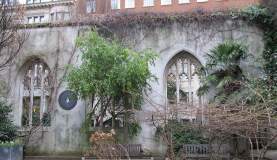St Dunstan in the East, and its one-time sculptural interest
A picturesque ruin with Wren tower, in the City of London, between Lower Thames Street and Great Tower Street, close to the Monument and also Tower Station.
St Dunstan's in the East as it was.
The tower and ruins of St Dunstan in the East, all that survived the World War II bombing, are on the site of a fayre and large Church of an auncient building, and within a large Churchyarde described by the antiquarian John Stow, writing around 1600. He mentions monuments from the 14th and 15th centuries, including a certain William Islip, Parson 1382, presumably a relative of Simon Islip, Archbishop of Canterbury who held the patronage of the church from 1365, various merchants, grocers, skinners and drapers, including Sir Bartholomew James, Draper, Mayor 1479, 'buried under a fayre Monument, with his Ladie ,and William Hariot Draper, Mayor 1481, buried in a fayre Chappell by him builded, 1517', and Sir John Hawkins, Elizabethan naval hero. A later rebuild exposed massive foundations of larger monastic buildings, a floor of glazed and ornamented tiles, and a 'perfect piscina, carved out of one block of Purbeck marble'.
Whatever was left of the old church was lost in the Great Fire, and Christopher Wren erected a new church on the site, aided by a large contribution (£4000) from Lady Dionys Williamson, of Hales Hall, Norfolk, a benefactor also towards St Paul's. The tower and open spire, which survive, were completed in 1698, a hundred years after Stow described the old church. The spire 'in a modern Gothic style... with four neat smaller spires, and the fifth or principal erected on four gothic arches', delicate as it looks with its fourribs arching up to bear the spire over open space is a remarkable thing. However, it is remarkably robust, and a hurricane in 1703 led Wren, on hearing that church spires across London had been severely damaged, to immediately remark that he felt sure St Dunstan's would be safe.
The rest of Wren's church was not so strong - the weight of the roof of the Nave began to push the walls outwards, and the edifice was rebuilt from the foundations, excepting the tower and steeple, from 1817-21. The architect was David Laing, assisted by William Tite, later architect of the Royal Exchange. The main entrance was through a porch with a groined ceiling at the north-east (see the picture), with a second, western entrance beneath the tower. The east window, of which the lower portion survives in the ruin, was modelled on the ancient one of the pre-Fire church.
The lost porch, with groined ceiling.
Mid-19th Century commentators noted the striking interior, the slender clustered columns, and pointed Gothic arches of stone. There were many 17th century tablets, and from the early 18th century, a large monument in the chancel to Sir William Russel, Knight, d.1705 incorporating a full length statue reclining on his left side, with flowing wig, shoes and buckles , and a monument to Sir John Moore, Mayor, d. 1702, 'builder of the Free School at Appleby in Leicestershire, his native County' and supporter of King Charles II. This latter monument was described as being well-preserved shortly before World War II. A separate panel commemorated his wife, Dame Mary Moore, d.1690. Another 'large monument' was to Colonel John Finnis, d.1857, killed in the Indian Mutiny in the East Indies.
But the church was bombed in World War II. Wren's tower and remarkable open steeple, inspired by St Nicholas Newcastle, survives (a similar tower is at Faversham), and the bombed out shell of the walls of the aisles and part of the nave, from Laing's building, survive up to different heights, with the interior and surround converted to a garden with flowers, climbing plants and benches, giving a picturesque ruin as if out of some Italian 18th Century picture. The window tracery can still be appreciated, including as mentioned the lower part of the East Window based on the pre-Fire church, and the odd small feature, such as an aisle pinnacle with delicate fronded carving, but there are no sculptures or statues left. And it must be noted that there is a second church dedicated to St Dunstan in the City of London - St Dunstan in the West, a replacement for a medieval church, but happily with many old monuments retained.
Ruined wall of one of the aisles.
Go West to St Mary at Hill // or East to All Hallows Barking // or South and West along Lower Thames St to St Magnus the Martyr



